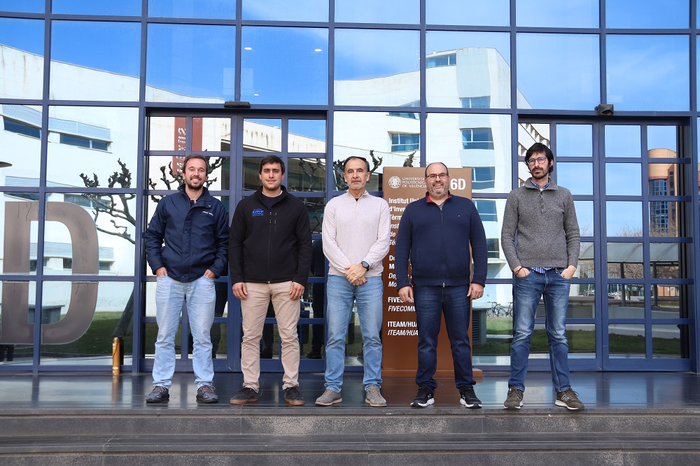At the Universitat Politècnica de València (UPV), belonging to the CMT-Motores Térmicos research institute, scientists are collaborating on various national and international projects to enhance the safety of lithium-ion batteries that are currently utilized in electric vehicles.
 Researchers of the CMT-Motores Térmicos Institute (UPV, Spain). Image Credit: Universitat Politècnica de València.
Researchers of the CMT-Motores Térmicos Institute (UPV, Spain). Image Credit: Universitat Politècnica de València.
As stated by Antonio García, a scientist at CMT-Motores Térmicos, the future of the automotive sector to a huge extent, even though not exclusively, depends on the immense use of lithium-ion electric batteries. There are a few issues at present, such as thermal stability, that might impact users’ safety
Lithium-ion batteries under certain conditions are not safe. There is a phenomenon known as thermal runaway, which can end up causing the battery to catch fire, with the consequent risk to the occupants of the vehicle.
Antonio García, Researcher, CMT-Motores Térmicos, Universitat Politècnica de València
García added, “The thermal energy released during this process is around 5.4 times the electrical energy contained in the battery, so extreme precautions must be taken. Thermal instability of batteries can occur under high demand conditions, for example during fast charging. If this is not managed well, it can go into thermal runaway and start a fire. As a note, a German city has already prohibited the parking of electric cars in underground garages.”
For such risks to be reduced, the UPV’s CMT-Motores Térmicos team is at present working on two European and two other national projects. They aim to better comprehend all the issues linked with the thermal runaway of lithium-ion batteries, both current and those that will make their way to the future market in the coming 15 years.
We are applying our more than 40 years of work focused on combustion engines to understand this phenomenon that affects lithium-ion batteries. We want to know even the smallest detail of the combustion process in batteries to help make them as safe as possible. And we already have our first results.
Javier Monsalve, CMT-Motores Térmicos, Universitat Politècnica de València
Among these is the development of an experimental installation, in partnership with AVL Ibérica, to be able to envision how the combustion process of a battery tends to develop.
Together with the analysis of the gases that have been discharged, the physical-chemical characterization of the process will be able to be performed under different conditions like different states of charge, the composition of the environment, etc. This will enable the development of chemical kinetic mechanisms linked to the process.
The UPV team is also collaborating on the DETEBAT-VE project, financed by the Generalitat Valenciana, which is concentrated on reorienting companies that currently offer services to Ford Almussafes towards electrification.
The objective of the project is to create a high-energy content battery pack demonstrator that allows the development and validation of the essential technologies to increase its driving range, safety and sustainability. From the CMT we work on the aspects of safety, thermal control and development of the battery energy management system.
Javier Monsalve, CMT-Motores Térmicos, Universitat Politècnica de València
NASA Interest
The study performed from the laboratories of this group at the UPV’s CMT-Motores Térmicos has piqued the interest of huge multinationals in the automotive sector, as well as the US space agency, located in NASA.
“The Agency has a department dedicated entirely to the study of these batteries, which are also key for the aeronautical sector. Last December we presented the conclusions of our most recent work in this sector at the NASA Aerospace Battery Workshop, which was very well received,” stated García.
On the Future of the Automotive
With the help of these projects, the CMT-Motores Térmicos group contributes all its knowledge to the future of the sector.
Antonio Garcia stated, “There will not be a single winning technology, “Because the future is eclectic. We have a global problem that is CO2 and, without the integration of hybrid electric vehicles (HEV), plug-in hybrids (PHEV), 100% electric vehicles (BEV), Fuel Cells, e-fuels, H2... it will be impossible to reach the objectives of reduction of emissions set for 2050.”
“We are working on this integration and, in this specific case, on helping to guarantee the maximum safety of lithium-ion batteries, which are key today and even more so in the not-so-long-term future,” added Antonio Garcia.
Journal Reference:
García, A., et al. (2022) Influence of environmental conditions in the battery thermal runaway process of different chemistries: Thermodynamic and optical assessment. International Journal of Heat and Mass Transfer. doi.org/10.1016/j.ijheatmasstransfer.2021.122381